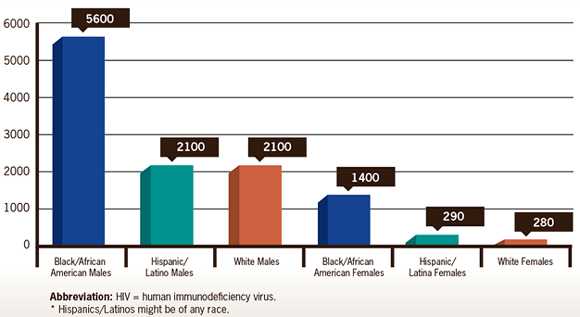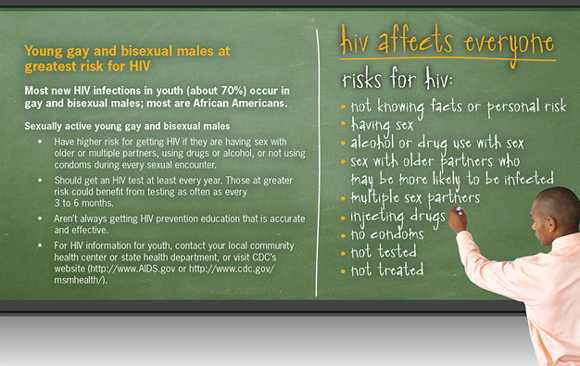HIV Among Youth in the US
Protecting a Generation
November 2012


 1 in 4
1 in 4
1 in 4 new HIV infections occurs in youth ages 13 to 24 years
 12,000
12,000
About 12,000 youth in 2010, or about 1,000 per month, were infected with HIV.
 60%
60%
About 60% of all youth, with HIV do not know they are infected, are not getting treated, and can unknowingly pass the virus on to others.
About 50,000 people are infected with HIV each year, and 1 in 4 is 13 to 24 years old. Youth make up 7% of the more than 1 million people in the US living with HIV. About 12,000 youth were infected with HIV in 2010. The greatest number of infections occurred among gay and bisexual youth. Nearly half of all new infections among youth occur in African American males.
The risk for HIV for most youth begins when they start having sex or start injecting drugs. HIV causes a serious infection that, without treatment, leads to AIDS and early death. All youth should know how HIV is transmitted and prevented, understand what puts them at risk for HIV, and be tested if they are at risk.
Problem
Many people get infected with HIV as a teen or young adult
New HIV infections in youth in 2010
- About 1 in 4 (26%) of all new HIV infections is among youth ages 13 to 24 years. About 4 in 5 of these infections occur in males.
- Nearly 60% of new infections in youth occur in African Americans, about 20% in Hispanics/Latinos, and about 20% in whites.
- Over half (54%) of new infections among young gay and bisexual males are in African Americans.
- About 87% of young males got HIV from male to- male sex, 6% from heterosexual sex, 2% from injection drug use and about 5% from a combination of male-to-male sex and injection drug use.
- About 86% of young females got HIV through heterosexual sex and 13% from injection drug use.
- More new infections occurred among young African American males than in any other group of youth by race/ethnicity and sex.
Most youth are not getting tested for HIV
- About 60% of youth with HIV do not know they are infected and so don't receive treatment, putting them at risk for sickness and early death. These youth can also unknowingly pass HIV to others.
- Young men are far more likely than young women to have HIV and are also less likely to get tested.
- African American youth are more likely to get tested for HIV than youth of other races or ethnicities.
- Youth who report being at risk for HIV are also more likely to get tested, but still many youth at risk have never been tested.
Many factors put youth at risk
- The risk for HIV for most youth begins when they start having sex or injecting drugs. (A small number of children are born with HIV.)
- For both males and females, having sex under the influence of drugs or alcohol can increase risky behaviors that could lead to becoming infected with HIV.
- The risk for getting HIV is higher in communities where a higher percentage of people already have HIV because partners are more likely to be infected.
- African Americans have a greater burden of HIV than other racial or ethnic groups in the US so they are at higher risk.
- Gay and bisexual men are 40 times more likely to have HIV than other men. Research has shown that young gay and bisexual males who have sex with older partners are at a greater risk for HIV infection. This is because an older partner is more likely to have had more sexual partners or other risks, and is more likely to be infected with HIV.
- Less than half (44%) of gay and bisexual males in high school used condoms the last time they had sex.
Preventing risky behaviors in youth
- Many effective programs reduce risky behaviors for youth. Prevention education for youth can be provided in the home, in schools, and in community and web-based programs.
- Youth, particularly those at high risk, should be taught early about HIV prevention with information they can understand and use. This includes education about risks and skills to help delay sex and prevent HIV infection.
- Youth who are sexually active can reduce their risk of HIV infection by choosing to stop having sex. They can also limit their number of sex partners, not have sex with an older partner who may be more likely to already have HIV, and use a condom every time.
- All youth at risk (sexually active or injection drug users) need to be tested and know where to get a confidential HIV test. Testing is the first step to getting medical care and treatment that can improve health, save lives, and prevent the spread of HIV.
Who's At Risk?
Number of new HIV Infections among youth by sex and race/ethnicity—United States, 2010

CDC. Vital Signs: HIV Infection, Testing, and Risk Behaviors Among Youths – United States. MMWR 2012:61

What Can Be Done
Youth can
- Get the facts about HIV and understand their risk.
- Get tested for HIV. Contact 1-800-CDC-INFO or text your zip code to Knowit (566948) or go to http://HIVtest.cdc.gov for more information and testing locations.
- Talk with parents, doctors, and other trusted adults about HIV, sexual health, and concerns about depression, drugs or alcohol.
- Resist pressure to have sex or inject drugs. Do not pressure others to engage in risky behaviors.
- Sexually active youth can reduce their risk by choosing to stop having sex, limiting their number of sex partners, not having sex with an older person who may be more likely to already have HIV, and using a condom every time. Don't have sex while using drugs or alcohol.
- Participate in HIV prevention programs, share HIV prevention information with friends and partners, and support other youth in protecting themselves against HIV.
- If you have HIV, get support, seek treatment, and stay in care to remain healthy and prevent passing the virus to others.
Parents and families can
- Talk with youth about HIV prevention.
- Ask your doctor about HIV testing and prevention for your youth, and ask your insurer if HIV screening is available without a co-pay, as required by the Affordable Care Act for most health plans.
- Engage in HIV education programs and support safe environments in schools for all youth.
- Make sure your community offers testing for HIV and sexually transmitted infections (STIs) as well as treatment for youth needing it.
Health care providers can
- Follow current HIV testing and treatment guidelines and test youth at risk for HIV. Sexually active young gay and bisexual men should be tested at least once a year. People in communities with more HIV infections may benefit from being tested more often.
- Educate parents and youth about sexual development, what puts youth at risk, and how to prevent HIV.
- Provide HIV prevention services tailored for youth and protect patient confidentiality.
Everyone can
- Get the facts about HIV and understand your risk. Get tested for HIV and other STIs. If you have HIV, get treatment and stay in care to remain healthy and prevent passing the virus to others.
- Engage in community and web-based education and other effective programs to prevent HIV and STIs among youth, particularly youth at highest risk.
- Combat the stigma and discrimination that keep young people, particularly young gay and bisexual males, from prevention and treatment services.
- Find out more about what CDC is doing about HIV at http://www.cdc.gov/hiv and http://www.cdc.gov/healthyyouth/sexualbehaviors.
Science Behind the Issue
Related Pages
- Vital Signs: HIV Infection, Testing, and Risk Behaviors Among Youths — United States, Morbidity and Mortality Weekly Report (MMWR)
- CDC Feature – HIV Among Youth: Protecting a Generation
- HIV Among Youth: Protecting a Generation – What You Need to Know [PODCAST – 1:15 minutes]
- HIV Among Youth: Protecting a Generation – What You Need to Know [PSA – 0:60 seconds]
- Winnable Battles – HIV
- CDC HIV/AIDS
- Adolescent and School Health.
- CDC Global HIV/AIDS
- CDC Vital Signs Report on HIV in the United States
- CDC Basic HIV Information
- Act Against AIDS
On Other Web Sites
- The Community Guide
- MedlinePlus – HIV/AIDS
- MedlinePlus – African-American Health
- MedlinePlus – Gay, Lesbian, Bisexual and Transgender Health
- MedlinePlus – Drugs and Young People
- World AIDS Day Statement from the White House
- AIDS.gov
HIV Testing
- Get tested for HIV. Text your zip code to Knowit (566948) on a cell phone or go to http://HIVtest.cdc.gov for more information and testing locations.
CDC Fact Sheets
- HIV/AIDS in the United States
- HIV/AIDS in the United States en espanol (VIH/SIDA en los Estados Unidos)
Many effective programs reduce risky behaviors for youth.
- Page last reviewed: November 27, 2012
- Page last updated: January 8, 2013
- Content source:
- National Center for HIV/AIDS, Viral Hepatitis, STD and TB Prevention, Division of HIV/AIDS Prevention
- Page maintained by: Office of the Associate Director for Communications (OADC)


 ShareCompartir
ShareCompartir